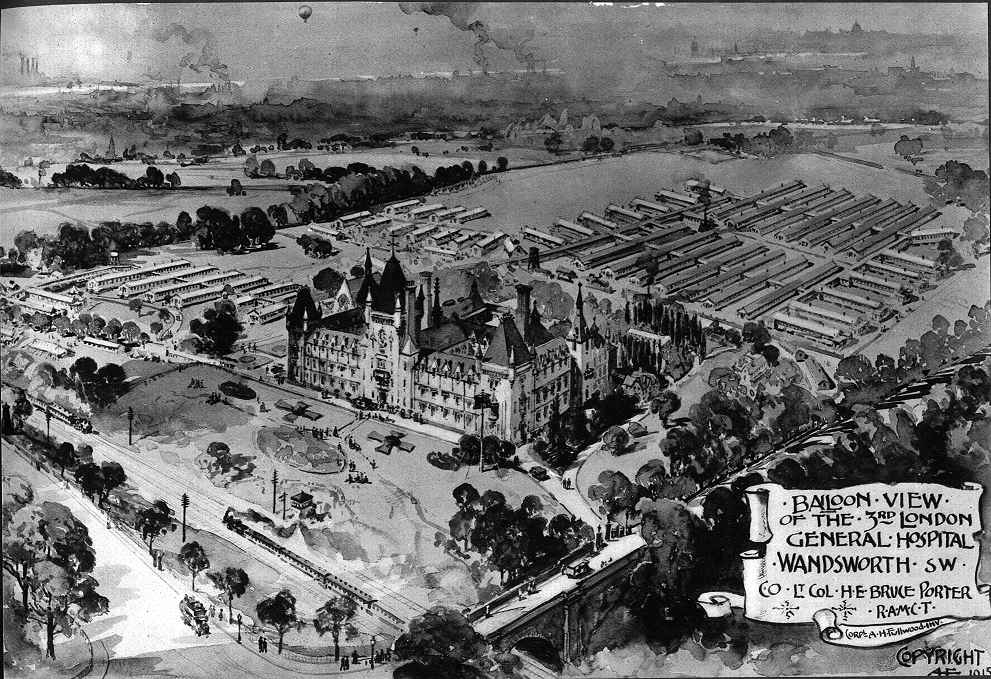

On July 1st. 1859, the London suburb of Wandsworth witnessed a noteworthy event-- the opening of a noble institution for the benefit of orphan daughters of soldiers, sailors. and Marines. The loyal Victoria Patriotic Asylum, as it was called, was the outcome of the Crimean War, it had been established and endowed from the Patriotic Fund which that tragic conflict evoked: and its foundation-stone had been laid by Queen Victoria, greatest of British sovereigns.
The fine edifice, grey and dignified, standing in the midst of its own beautiful lawns, has seen the comical and doing of many orphan girl children since then, and it is - alas- likely to be the home of many more. But for the moment it has been emptied of its usual inhabitants (who are housed close by), and "The Patriotic School," as it is locally named has been converted to another - but wholly appropriate - purpose. It has been made the nucleus of a War Hospital, the 3rd London General, now one of the biggest in the British Isles.
This transformation took place automatically in August, 1914, in consequence
of the far-sighted arrangements made by Sir Alfred Keogh. Then the Territorial
Force was founded, it was Sir Alfred Keogh who planned its medical organisation,
and under his scheme certain public buildings were earmarked for employment
as hospitals in the event of war.
"The Patriotic School " at Wandsworth was one of these buildings, and the promptitude with which it was occupied for its present use may be gathered from the fact that already on August 5th. 1914, the day after the declaration of war - twenty N.C.O.'s and men had arrived (under the charge of the late Maj.. Miller) to make the initial preparations, while Lt.-Col. Bruce Porter, the hospital's Commanding Officer was simultaneously busying himself with the negotiations for equipment.
The metamorphosis of the school into the hospital was an extremely complicated task: not only had practically all the school's furniture to be removed, but many structural changes were made - the windows altered, hopper sashes put in, lavatories and baths attached to those rooms which were to become wards, and so forth. In this rapidly performed, though laborious task the N.C.O.'s and men to whom the first credit is due were supplied from the Unit (founded long before the war and gallantly kept up even at a time when peace seemed assured) by the City firm of Messr's Hitchcock, Williams. and Co. Sir Alfred Pearce Gould. the late Sir Victor Horsley, Capt. Humphris Capt. Dodson, Sir Shirlev Murphy, and Col. Russell assisted the CO. to superintend the work in all its details. The hospital's staff (medical and surgical) was supplied from the Middlesex, St. Mary's, and University College Hospitals - these provided virtually the whole of the officers available on mobilisation.
Almost immediately it became apparent that the size of the Patriotic
School would be insufficient, and the first of the extensions (now known
as the Letter Block) was put in hand. This long corridor of huts (and operating
theatre) was built in the short space of eight weeks, its architect was
Mr. Pain Clarke: when completed, the hospital had 520 beds.
It now has 1,800, for vast new extensions have been added, stretching, out beyond the original hospital grounds on to land which had been prepared as a recreation place been Wandsworth by the London County Council. These extensions, which include not only magnificent wards (of a new pattern), but also kitchens, recreation room, new operating theatre, X-ray department, stores. bathrooms, and boardroom. have enabled a portion of the main building to be taken for office purposes; but though " Bungalow Town," as the ward huts have been called, now shelters the largest proportion of now patients, the affection of all will continue to centre round the Patriotic School. The memory of its impression facade and turrets, rising in silhouette against the pale sky of the Metropolis, will be carried home to many a far county of these islands and many a colony of that Empire of which London is the heart.